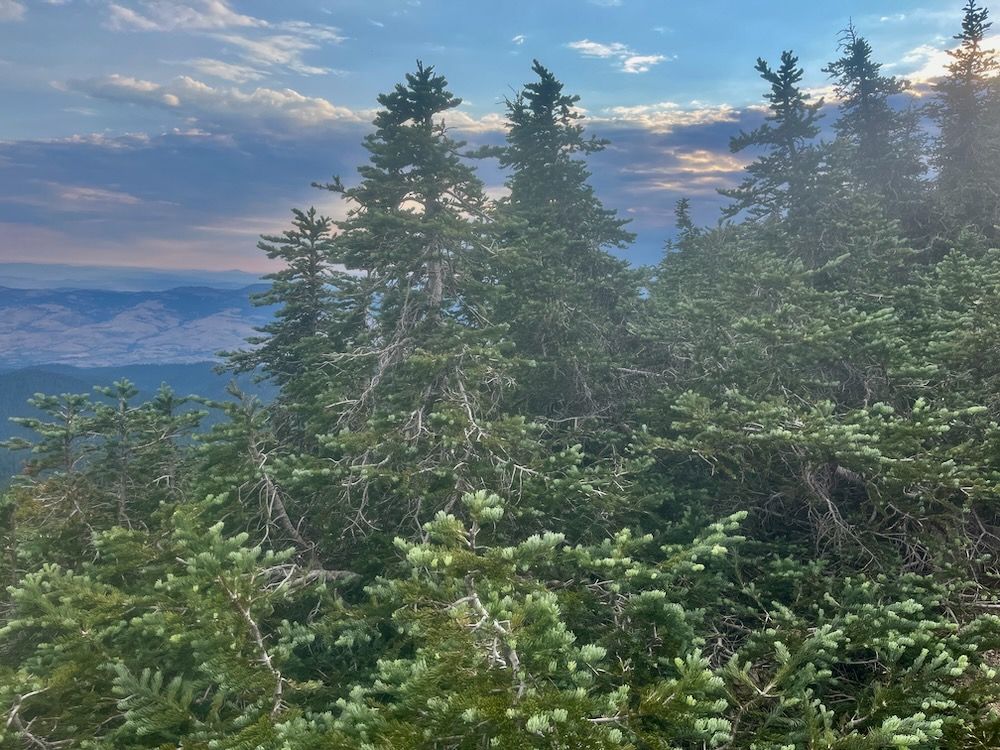
Death By A Thousand Cuts: The Destruction of Subalpine Fir and the Continued Impact of Ski Resort Development on Mt. Ashland
The Unique Ecology, Recreational Values and Conservation Benefit of Mt. Ashland
Mt. Ashland is the highest peak in the Siskiyou Mountains and one of the most popular recreation areas in southwestern Oregon for hiking, camping, mountain biking, botanizing, and recreational driving along Road 20. Well loved, but over developed, the Mt. Ashland area has been suffering a death by a thousand cuts ever since the initial ski resort development in 1964, and impacts are steadily growing on the mountain. Together the concentrated recreational use, the history of road building and grazing, the industrial ski resort development and the development of local communication facilities have all created significant cumulative effects and damage to unique natural habitats, species, and scenic values on the mountain.
Mt. Ashland lies at the edge of the McDonald Peak Inventoried Roadless Area at the headwaters of Ashland Creek, and in the city of Ashland’s municipal watershed. The McDonald Peak Inventoried Roadless Area contains towering old-growth forests, lush mountain meadows, swift mountain streams, sagebrush clearings and granitic outcrops with spectacular vistas. Mt. Ashland is also a premiere botanical resource and is one of the most well-loved Botanical Areas designated on Forest Service land in the Siskiyou Crest region.
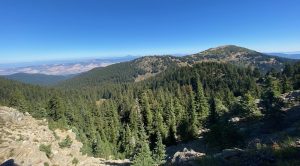
The summit area and northwestern flank of the mountain contains the world’s only population of the endemic Mt. Ashland lupine. Found on only approximately 45 acres, this is one of the rarest plant species found in the Siskiyou Crest region, and a narrow endemic to only Mt. Ashland. The mountain also contains rare species such as Henderson’s horkelia, Jaynes Canyon buckwheat, and disjunct conifer species found outside their prevailing range.
These disjunct conifer populations include:
- whitebark pine (Pinus albicaulis), which was recently listed as threatened under the Endangered Species Act
- Engelmann spruce (Picea engelmannii), which is at the southern extent of its range
- subalpine fir (Abies lasiocarpa), which is found in only two locations in the entire Siskiyou Mountains range.
Historic construction of the Mt. Ashland Ski Area likely led to the destruction of significant portions of these rare conifer stands, including the removal of whitebark pine and subalpine fir trees. Early botanist John Leiberg traveled the region in the early 1900s and found “a few score” whitebark pine in the region — now only three trees remain near the summit of Mt. Ashland. It is apparent that trees were removed and habitats were permanently degraded through ski run and chairlift development. All three disjunct conifer species are adapted to heavy snow loads, alpine environments, and are highly susceptible to localized extirpation due to the small size of the populations and the limited habitat found on the mountain. Being found on or near the summit of Mt. Ashland, the subalpine fir, whitebark pine, and perhaps other species such as Mt. Ashland lupine, have nowhere higher to migrate to under a changing climate. They are already restricted to the highest portions of the Siskiyou Crest’s highest peak and are already growing on the edge, in marginal habitats, and in narrow climate refugia where snow lingers late into the summer months.
Subalpine Fir (Abies lasiocarpa) at Mt Ashland and the Impact of Ski Resort Development
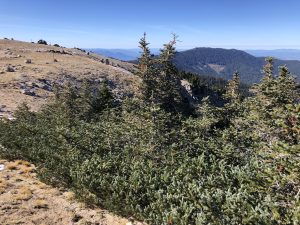
It is thought that the subalpine fir is a Holocene relict, more common in our region between 5,000 and 7,000 years ago, and in the Little Ice Ages when climactic conditions were far more cool, moist and snow packs were far more pronounced. The species may have moved into the area as it colonized land previously occupied by headwater glaciers during the cooler periods of the Pleistocene. The melting of these headwater glaciers allowed for the development of subalpine conifer forests, including subalpine fir. Over time, the subalpine fir was isolated in the most intense climate and fire refugia, clinging to cool, moist sites at high elevations, where winter snow accumulates and summer drought hardly penetrates.
Early documentation of Mt. Ashland claims that the summit area held deep snow drifts and heavy winter snowloads; therefore, the summit likely contained habitat for species like subalpine fir across a broader geographic landscape and at lower elevations than it does today. Slowly, the climate has warmed and the species has moved upward, now occupying only the very summit of the mountain. With the climate changing at an increasingly alarming rate, the already small population of subalpine fir is more vulnerable to exterior stressors, anthropocentric impacts, and more dramatic climatic swings than ever before.
Subalpine fir is a tree of the snow zone, isolated in only two highly disjunct populations on the Siskiyou Crest: at Mt. Ashland and on the eastern flank of Tanner Peak in the Illinois River watershed. Although it is not known how large the population was on Mt. Ashland before ski area and communications development, the population had decreased to just 0.1 acres of stunted krummholz-form (naturally occurring bonsai-like form) subalpine fir trees growing in a dense mat with an unknown number of stems. This krummholz mat clings to the mountain’s northern summit above Mt. Ashland’s so-called “bowl,” a deep glacial moraine at the headwaters of Ashland Creek. This is the last place on Mt. Ashland to lose its snowbanks to the summer heat and the most alpine environment on the mountain.
Unfortunately, just this past week, it was discovered that the Mt. Ashland Ski Area Association had cut down the vast majority of the subalpine fir trees on Mt. Ashland, leaving only a couple small trees in this small (now smaller), but beautiful krummholz grove. The impact will diminish this already vulnerable conifer population and could lead to the localized extirpation of this species on Mt. Ashland. Currently only a couple small trees remain and the loss to localized biodiversity, to the area’s unique ecology and to thousands upon thousands of years of evolution is heartbreaking, to say the least.
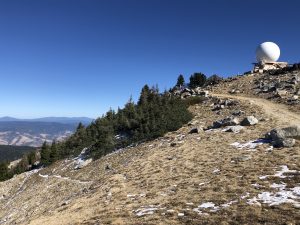
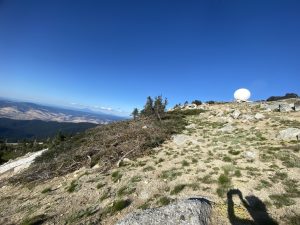
The subalpine fir has survived in this location for thousands and thousands of years, hanging on as a relict, or remnant left over from past climates and as an expression of the Siskiyou Crest’s unique role on the landscape. The population exists as a tangible representation of the area’s world-class biodiversity, spectacular habitat complexity, and the areas pronounced climate refugia, and the impacts to the subalpine fir population are devastating to local botanists and other who love this region.
Ironically, the impacts to this stand could have easily been avoided with proper oversight by the Rogue River-Siskiyou National Forest that is tasked with managing this land for public benefit, but is currently letting the Mt. Ashland Ski Area Association operate far to freely in their management of public forests, wildlands and biodiversity at Mt. Ashland. The impacts also could have been easily avoided had the Mt. Ashland Ski Area Association done their job of stewarding this landscape, rather than exploiting it in their desire to expand and increase revenue. The fact of the matter is that world-class wildlands and biodiversity do not mix well with industrial ski resort development, and Mt. Ashland is showing the signs of abuse and commercial exploitation.
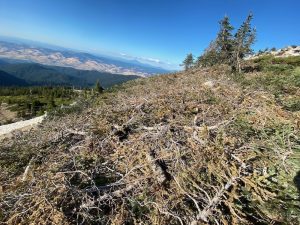
Currently we do not know why the subalpine fir trees were cut down, or if the activity was authorized by the Forest Service or Mt Ashland Ski Association — we can only guess and we are working to get verification through the Forest Service supervisor’s office. What we do know is that another piece of Mt. Ashland’s natural history, botanical mystery, and biological complexity has been destroyed through either negligence, ignorance, and/or a lack of consideration for the spectacular and unique ecology on Mt. Ashland — the Siskiyou Crest’s tallest mountain.
Clearcutting A New Ski Run
At the same time that the subalpine fir trees were cut, the Mt. Ashland Ski Area also clearcut a new ski run in mature montane forest on Rogue River-Siskiyou National Forest land. Benignly calling this the “Bumble Bee Ski Run,” we are told by the Forest Service that this project was approved 24 years ago in the Mt. Ashland Ski Expansion Project. The Mt. Ashland Ski Area Expansion was highly controversial and if constructed in full, it would have devastated the mountain’s unique ecology, old-growth forests, rare plant species, roadless wildlands, and relict stands of Engelmann spruce. Approved, but thankfully never fully implemented, this project was proposed to dramatically expand the ski slopes by clearcutting runs into old-growth forests and the McDonald Peak Inventoried Roadless Area, blasting boulders, grading meadows, installing chair lifts, building new lodges, roads and infrastructure all across the northern face of Mt. Ashland and in intact high elevation meadows and forests.
The newly built Bumble Bee Ski Run was cut into mature montane fir forest consisting mostly of red and white fir stands. Many trees over 200 years old and over 30″ DBH were logged in the new ski run, leaving behind a linear clearcut and heavily disturbed stumpfield with all the same effects as clearcut logging, only rather than recovering over time, this clearcut will be maintained and actively deforested by the Mt. Ashland Ski Association for the foreseeable future.
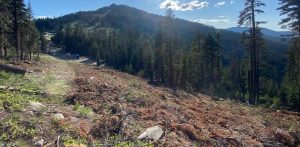
Located within the Mt. Ashland Ski Areas permit area, but adjacent to old-growth forests on federal lands in the McDonald Peak Inventoried Roadless Area. The run was cut into undisturbed montane forest at the headwaters of East Fork Ashland Creek, where the Mt. Ashland Ski Area continues to be the only significant impact in the otherwise intact, roadless upper watershed. This new run is associated with and served by the new Lithia Chair Lift which was paid for with $2 million from Sid and Karen DeBeor Foundation & $500,000 privately from Sid and Karen DeBeor. The new chair lift was completed in October 2024 and was the precursor to the recent clearcutting of the Bumble Bee Ski Run. These impacts add to recent and historic impacts sustained across the upper slopes of the mountain, and the majority of the thousand cuts inflicted against the ecology of Mt. Ashland have been sustained through ongoing ski resort development.
Future Chairlift Improvement Projects
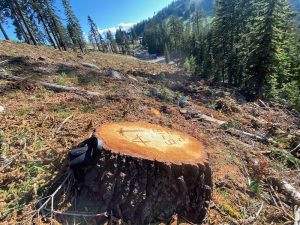
Currently, the Forest Service is also considering authorization of a chair lift improvement project on Mt. Ashland and is proposing to utilize a Categorical Exclusion with little to no meaningful environmental analysis and without requiring additional botanical and sensitive species surveys before approving the project. The recent destruction of Mt. Ashland’s subalpine fir grove demonstrates a more formal and detailed process is required for projects of this scale and should include a full Environmental Analysis (EA) for any new development, or for significant infrastructure upgrades on Mt. Ashland. The removal of these rare trees will have significant long-lasting impacts to the ecology of Mt. Ashland and demonstrates that moving forward without sufficient analysis and Forest Service oversight should not be an option. Additionally, the 24-year-old Ski Expansion documents are no longer valid, do not reflect the environmental conditions of today, and should be withdrawn by the Forest Service before they are abused further.
Protect Mt. Ashland!
Mt. Ashland is public land, and should be managed for biological and public benefit, not solely for the interest of the Mt. Ashland Ski Area and Mt. Ashland Ski Association. Rules should apply to Mt. Ashland and public oversight by the Forest Service needs to dramatically increase if the mountain’s unique natural legacy is to be protected, sustained, or enhanced. The death by a thousand cuts can br curtailed if the Forest Service reasserts their ownership over these lands, demands accountability from the Mt. Ashland Ski Association, and stops the continued development of our beloved mountain. Our public lands are not for sale, and they should not be managed solely for the benefit of industrial interests, including ski resorts like Mt. Ashland.
I grew up in Ashland and skied Mt. Ashland as a kid, but I do not condone the continued devastation of the mountain I love and have been connected to my entire life. I also spent day after day on Mt. Ashland and in the surrounding McDonald Peak Inventoried Roadless area as a youth — skipping high school classes and spending weekends backpacking the wildlands of the Ashland watershed. Starting in Lithia Park, I would climb the then trailless ridges and canyons to Mt. Ashland’s summit and traverse the ridgetops to McDonald Peak or Wagner Butte. I slept out on the flank of Mt. Ashland under full moons, star-filled new moons, and meteor showers, in winter snows and through summer lightning storms. Mt. Ashland was one of the areas that taught me a love of place and showed me how lucky I was to be raised in SW Oregon among the wildlands.
I came out of the backwoods timber protest movement, and learned through my opposition to the Mt. Ashland Ski Expansion how to defend wildlands with community activism, passionate public advocacy, science, administrative process, political pressure, and litigation. At 17 years old, I led hikes through the forest proposed for clearcut ski run and chair lift creation, wrote articles in opposition, advocated in the community, and shared my love of this place with anyone who would listen. I also experienced the threatened wildlands and was humbled by the silence and peaceful solitude of the Siskiyou Crest. Each hike filled me with a profound sense of place, a sense of responsibility to that place, and my first experience with the sacred. It was through direct immersion in nature that I learned to love these wildlands and built relationships that continue to define my life today. For that I can thank Mt. Ashland and the McDonald Peak Roadless Area.
I mourn the loss of the subalpine fir and the recent impacts to Mt. Ashland’s unique natural character. I will also continue to speak out on the mountain’s behalf, and encourage you to do the same. Do you love Mt. Ashland? If you do, please become part of its voice, and help us advocate, defend, and maintain its beauty, diversity, and intact natural character. Although much has been lost over the years at Mt. Ashland through ski resort development, we still have much to defend. Join us!
Contact the Rogue River-Siskiyou National Forest and tell them:
1) You are outraged by the recent cutting of subalpine fir on Mt. Ashland and the lack of Forest Service oversight for activities implemented at the Mt. Ashland Ski Area.
2) The continued development of Mt. Ashland should be curtailed and the 24-year-old Mt. Ashland Ski Expansion EIS document should be withdrawn.
3) Clearcut ski run logging is impacting the biological values, watershed values and the Ashland Creek Municipal Watershed. Please do no authorize anymore ski run development and require the Mt. Ashland Ski Association to operate in the existing resort footprint.
4) The upcoming Ski Lift Improvement Project should require a full Environmental Analysis (EA), sensitive species surveys, strict Project Design Features to protect montane habitats, and far better Forest Service oversight.
4) The Forest Service should make efforts to better sign and protect rare plants on Mt. Ashland, including increased signage and boulder placement at the summit area to protect rare flowering plants and conifer species.
Email Forest Supervisor Molly Juillerat:
molly.juillerat@usda.gov
Contact the Mt. Ashland Ski Association and tell them:
1) You are outraged by the recent cutting of subalpine fir on Mt. Ashland.
2) You are disappointed by the continued development of Mt. Ashland Ski Area and the clearcutting of the new Bumble Bee Ski Run, which cut trees over 200 years old and over 30″ diameter in mature and old-growth montane fir forest at the headwaters of East Fork Ashland Creek.
3) The Mt. Ashland Ski Area should stay within their current footprint and commit to not expanding into the McDonald Peak Inventoried Roadless Area.
4) The Mt. Ashland Ski Association should participate in the monitoring and protection of rare species on Mt. Ashland, including what remains of the subalpine fir population, the whitebark pine population, the Engelmann spruce groves, the Mt. Ashland lupine, Henderson’s horkelia, and Jaynes canyon buckwheat. The Mt. Ashland Ski Area should strive for no impact on these species and commit to no more logging of mature and old-growth montane forest within the Mt. Ashland Permit Area or within the McDonald Peak Inventoried Roadless Area.
5) No growth outside the existing ski runs and chair lift footprint is good stewardship.
Email Mt. Ashland Ski Resort:
info@mtashland.com
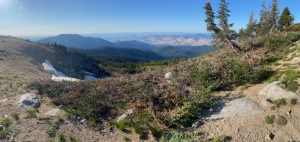
Subalpine fir cut down on the top of Mt. Ashland, with the city of Ashland located in the valley below.
